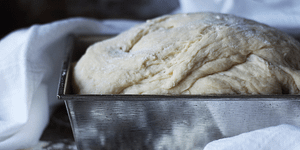Mull it Over: Mulberries, Memories, and Muffins

Mulberries have a special power of unlocking memories. Catching a whiff of a pie in the oven or taking that first delicious bite will transport you back to not only the first time you had mulberries, but each and every time.
These sweet berries very well might be in your own backyard, your neighbor’s yard, or your local park. Pick some this summer, throw them in the freezer, and bake a pie or muffins in the colder months that will remind you of the warmer summer days.
The following excerpt is from The Fruit Forager’s Companion by Sara Bir. It has been adapted for the web.
The Magic of Mulberries
Morus spp. Moraceae family found throughout the US and Canada.
Mulberries are trees of memory, if you happened to grow up around one. There will never be mulberries sweeter and juicier than the ones gathered from a tree that grew where you played during your childhood.
That’s the rub with mulberries, for in adulthood they never fully live up to our expectations. Other berries are more flavorful and juicier, particularly blackberries and raspberries—which mulberries resemble at first glance. Mulberries are not related to caneberries, though, and forever mulberries will be poseurs, early-summer stand-ins for the blackberries and raspberries yet to come.
I still love mulberries. They are fun to gather, and one must admire their productivity. In a good year a single mulberry tree will provide enough easily harvestable fruit for a procession of pies. And that’s even after the birds have feasted. Mulberries give and give, to the consternation of homeowners who prefer their driveways unstained and sidewalks free of sticky smears. Don’t park your car under a mulberry tree when it’s fruiting.
The berries will stain your car, and the birds in the branches who’ve been gorging on the berries will also unleash their berry shits on it. (When mulberry-tainted bird poop lands on the sidewalk, it’s a swirly lilac-white, pretty in its way.)
Mulberries: A Berry of Many Colors

Don’t put too much stock in its name, as it can bear fruit that’s either purple-black or white when ripe. So confusing! The color of the berries will depend on the individual M. alba in question, as will their flavor. The tastiest mulberries I’ve sampled were the white-when-ripe kind, as were the most underwhelming. Don’t give up on mulberries of any color if you sample a dud. Keep on looking, and keep on tasting.
Jump-Starting the Silk Industry
M. Alba was introduced in a short-lived craze for cultivating silkworms, an interesting footnote in American history. The hope was to jump-start a profitable silk industry, beginning by planting white mulberry trees to host silkworm larvae. Schemers hoping to get rich planted mulberries in orchards and hedges. Once the trees were mature enough to host the larvae, the labor required to spin the silk outweighed the quality of the final cloth itself, and our fledgling silk industry fizzled out, beginning with the financial Panic of 1837. You’ll now find M. alba (most of them with dark-when-ripe berries) coast to coast, and white mulberries are often classified as invasive.
While mulberries are not a commonly recognized fruit, they are familiar to some as place names. There’s a Mulberry Street in my town, a quiet alley with brick pavers. It only spans a block, and I’ve walked down it dozens of times looking for the eponymous mulberry trees. I’ve spotted two crab apple trees and a grape arbor, but alas! No mulberries. I imagine they were cut down years ago.
The Origin of Mulberries
The dark mulberries you are most likely to come across will stain hands and fingers a purplish blue-red; once I was out gathering mulberries with my dog, and the fringes of his white fur were purple for a few days (he’d sat in a pile of fallen berries). Not surprisingly, mulberries make a fantastic natural pigment for dyes and inks. The legend of the lovers Pyramus and Thisbe contains an origin story for the black mulberry tree along these lines: It started out as a white mulberry tree in a cemetery where the couple had planned to meet.
Thisbe arrived first, and startled at the sight of a lioness, she fled, snagging her veil and scraping herself on the mulberry tree in the process. When Pyramus arrived shortly after, he saw the veil, presumed the lioness had gobbled up Thisbe, and killed himself. When Thisbe returned, she offed herself, too. Such a dramatic bloodbath stained the mulberry tree forever.
My favorite mulberry trees grow in a cemetery, as it turns out. I am there to meet no forbidden love, and the most threatening animals there are not roving lionesses, but groundhogs who have dug vast networks of burrows. I’m afraid my dog may get in a scrap with one, so I keep him close on the leash as I collect berries under the gentle shade of the trees.
Harvesting Mulberries
It’s very possible to just walk up to a mulberry tree and pick the ripe berries. What’s faster—and more fun, in my opinion—is to get down on the ground and gather up the ripe ones that have already dropped (wear shoes whose soles you don’t mind getting gooey and purpled). Inevitably more ripe berries will plummet down as you do this, making tiny thumps to punctuate the backwash of bird sounds and cars driving by.

Picture of Sara Bir courtesy of Melanie Tienter
That method is only fun if the tree grows on a softly tufted spot. My favorite mulberry trees are carpeted below with moss and creeping Charlie, and rifling through their greenery is soothing.
For efficiency, bring a sheet or tarp along and spread it on the ground beneath the branches. Shake the branches, and the ripe berries will rain down. Don’t pile them up too high in the pail or bin, because the pressure of the top ones will mash down the bottom ones.
Uses & Storage
Use mulberries quickly; they bruise easily, which is one reason you don’t see them in grocery stores. Also, if you’ve plucked them from the ground, sort through them carefully; I’ve pulled a few sneaky mulberry-sized rocks out of my berry clutches before. You may notice some tiny critters of the baby insect variety venturing out from the mulberries’ crevices. Don’t think about it too much, and just chalk it up to extra protein.
Mulberries freeze well. Stockpile a whole bunch if you love baking pies, and draw upon them in the winter, to remind you of sun-dappled afternoons gathering them in your sandals.
Mulberries have a tiny segment of a green stem sticking from their tops. These things look like minute inchworms and are cute in their way. There’s no need to trim them off, as doing so will madden you unnecessarily. I do find the stems visually distracting, though, so think of ways to disguise them: Bake mulberries in muffins, hide the stems under the top crust of a pie, or infuse mulberries in a kompot or shrub that will be strained later.
The Culinary Possibilities of Mulberries
Besides their delicacy, the other reason you don’t see mulberries in grocery stores is that they taste underwhelming, a bit wan and vegetal. They are enough like blackberries to remind us of blackberries, but they will never be blackberries (the Who didn’t include a verse about mulberries in the song “Substitute,” but they very well could have). Also, once cooked down, mulberries have a watery texture that makes them unsuitable for quickly cooked compotes and sauces. I’ve never made mulberry jam (the stems are texturally problematic), but if you do, you are best off adding pectin.
Good white mulberries are wonderful right from the tree, but I’ve never cooked with them (partly because my favorite white mulberry tree is ringed with poison ivy and hard to get close to safely). I’m not sure if their more honeyed, floral flavor would do well in pies and jams, or what white mulberries would look like after cooking—a pale, sludgy mess?
What you do with mulberries will depend on how you feel about them. A sentimental attachment is very helpful in enjoying them to their fullest, as is a heavy hand with sugar and spice (mulberries need all the help they can get). A squirt of citrus plays up their fruitiness.
You are best off thinking of mulberries as a team player with other, more flavor-forward fruits. Rhubarb’s tartness is a fantastic partner for mulberries (“The berry-rhubarb team makes one of the most economical farm fruit pies—and one of the best,” according to Farm Journal’s Complete Pie Cookbook).
RECIPE: Multigrain Multi-Berry Muffins
Makes 12 muffins
As much as I love pancakes, it’s so easy to stir together a bowl of batter and stick a bunch of muffins in the oven—it frees me up to read the newspaper instead of standing over a griddle.
Ingredients:
- 1 cup (145 g) whole wheat flour
- 3⁄4 cup (70 g) oat flour
- 1⁄4 cup (30 g) ground flaxseeds
- 1 tablespoon baking powder
- 1⁄2 teaspoon salt
- 1⁄2 cup (100 g) granulated sugar
- Finely grated zest of 1 orange
- 1⁄2 cup (120 ml) orange juice
- 1 cup (240 ml) unsweetened nondairy milk
- 1⁄3 cup (80 g) melted coconut oil
- 11⁄2 teaspoons vanilla extract
- 2 cups (290 g) ripe but sturdy berries, such as mulberries or blackberries
Instructions:
Preheat the oven to 375°F (190°C). Grease a 12-cup standard muffin tin.
In a large bowl, whisk together the flours, flaxseeds, baking powder, salt, and sugar.
In a medium bowl, whisk together the orange zest and juice, milk, oil, and vanilla. Add the flour mixture, and fold with a rubber spatula just until combined (a few small lumps are okay). Fold in the berries.
Divide the batter among the prepared cups, filling each no more than two-thirds full (I use an ice cream scoop). Bake until the centers of the muffins spring back when lightly pressed and a toothpick inserted in the center comes out clean, about 20 minutes. Cool the tins on racks 2 minutes, then remove the muffins from the tins.
NOTE: You can line the tins with paper muffin cups, but I prefer the texture of muffins baked without them.
ALSO TRY WITH: Blueberries, huckleberries, blackberries. You could also throw in a few fresh cranberries, if you like, or substitute some raspberries for a portion of the other berries (an all-raspberry muffin will wind up too dense).
Recommended Reads
The Radiant Raspberry: Foraging For and Cooking With Wild Raspberries
The Hunt for Wild Huckleberries and Buckwheat Huckleberry Buckle Cake
Recent Articles
Want to spice up your traditional bread recipes? This salt-rising bread recipe by fermentation expert Sandor Ellix Katz has all the simplicity, flavor, and uniqueness you’ve been searching for! The following is an excerpt from Sandor Katz’s Fermentation Journeys by Sandor Ellix Katz. It has been adapted for the web. What Is Salt-Rising Bread? Salt-rising…
Read MoreNothing says “spring” like a fresh, foraged meal! Savor the flavors of the season with this Milkweed Bud Pizza recipe.
Read MoreWhat’s so great about oyster mushrooms? First, you can add them to the list of foods that can be grown indoors! They are tasty, easy to grow, multiply fast, and they love a variety of substrates, making oyster mushrooms the premium choice. The following is an excerpt from Fresh Food from Small Spaces by R. J.…
Read More









